.
28.12.2014
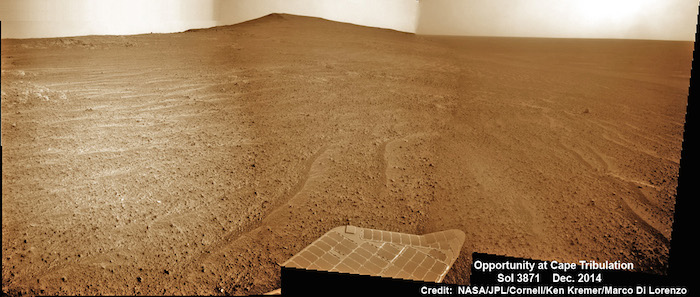
NASA’s Opportunity Mars rover scans to the summit of Cape Tribulation less than 100 meters distant in mid-December 2014. Beyond lie caches of clay minerals. The scene shows impact breccias and thin soil cover with cobbles over bedrock. This navcam camera photo mosaic was assembled from images taken on Sol 3871, Dec. 13, 2014, and colorized.
.
The longest living Red Planet rover ever crafted in human history is about to accomplish another astounding feat along her astonishing 11-year trek across the most Earth-like planet in our Solar System.
NASA’s Opportunity rover is within reach of the summit of Cape Tribulation, heading southwards along gigantic Endeavour crater—and it counts as the highest Martian mountain she will ever scale in her unbelievably incredible and momentous life of exploration and discovery.
“Opportunity will stay a few sols (or Martian days)” at the summit spot called “Summit Lithology,” Prof. Ray Arvidson, the rover Deputy Principal Investigator of Washington University told AmericaSpace exclusively today.
Opportunity is now at an elevation of some 1,380 meters!
What does the peak of Cape Tribulation look like?
“We are currently sitting on the slope extending westward from [Endeavour crater] rim rocks, an area that looks very much like a sediment shaped by wind. Thin soil cover, with cobbles, over bedrock.”
.
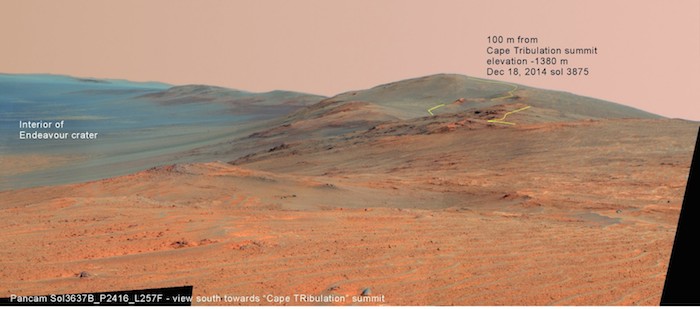
NASA Opportunity rover’s current location near the summit of Cape Tribulation in late December 2014 on Sol 3875 is shown in this prior panoramic view looking south along the rim of Endeavour crater. It is centered on the highest part of the rim of Cape Tribulation. It was acquired back on sol 3767 and shows the subsequent traverse of Opportunity as a yellow line. Note that Opportunities traverse drops out of view periodically as it negotiates valleys between ridges. Credit: NASA/JPL/Cornell/NMMNHS/Larry Crumpler
.
Arriving at Cape Tribulation has been a long-sought goal of the science team because it puts the six-wheeled rover in a region of clay minerals that’s a scientific goldmine, since they formed in neutral liquid water billions of years ago when the Red Planet was far warmer and wetter and thus much more conducive to the formation of Martian microbes, if they ever existed.
At the summit, Opportunity will perform some important science observations and then march onward to the clay minerals.
“One more key science target before then and that is a last set of measurements on the Shoemaker formation breccias, at a stop called summit lithology,” Arvidson elaborated.
The ancient, weathered slopes of Cape Tribulation hold a motherlode of the “phyllosilicate” clay minerals, based on data obtained from the extensive orbital measurements made by the CRISM spectrometer, accomplished earlier at the direction of Arvidson.
The clay minerals were detected from orbit by the CRISM spectrometer aboard NASA’s powerful Martian Spysat—the Mars Reconnaissance Orbiter (MRO)—while gathering context data at rock outcrops along the long and winding way over the past few years.
The robot’s science team specifically directed Opportunity toward Cape Tribulation several years ago, based on the detection of abundant exposures of aluminum-rich clay minerals at a spot a bit beyond the summit, called “Marathon Valley,” using the spectral measurements from CRISM and MRO.
“Opportunity remains only a few sols at the summit lithology before going to Marathon Valley,” Arvidson stated.
“Today, we are about 500 meters from ‘Spirit of Saint Louis’ crater at the entrance to Marathon Valley (named because the rover will have traveled one marathon’s distance to reach it)!”
As of today, the rover is less than 100 meters’ drive from Tribulation’s summit, according to rover science team member Larry Crumpler of the New Mexico Museum of Natural History & Science (NMMNHS), in an update.
“The outcrops are few and far between up here, but so far all of the outcrops along the rim have been impact breccias. Some are more altered than others. The devil is in the details,” says Crumpler.
.
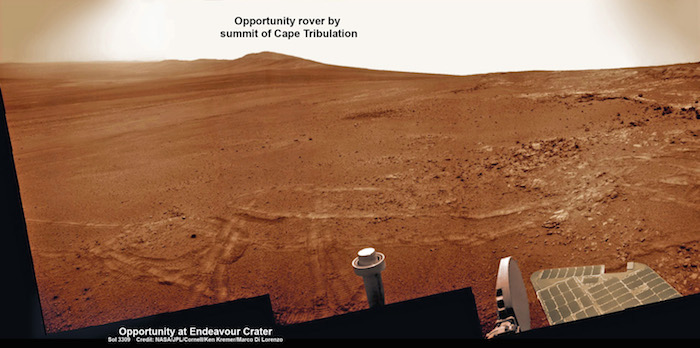
Opportunity rover’s current location by the summit of Cape Tribulation in late December 2014 on Sol 3884 is shown in this prior panoramic navcam mosaic view looking south along the rim of Endeavour crater on Sol 3309 on May 15, 2013, where she discovered clay minerals at Esperance rock at Cape York. Credit: NASA/JPL/Cornell/ Ken Kremer
.
The superlatives are never ending for the world-famous and world-renowned Opportunity Mars Exploration Rover (MER), as she not only climbs to the peak of her tallest mountain but also is now less than one month away from celebrating her 11th year driving about the surface of Mars.
And the view from the summit promises to be spectacular, looking back into the vast expanse of Endeavour crater from atop the eroded and tall rim segment at Cape Tribulation.
The navcam and high-resolution pancam cameras will gather superlative views.
“The panoramic view from that summit should be awesome. Mid summer [in Mars southern hemisphere] is only a few sols away,” says Crumpler.
“In the next few drives it will be at or near the highest peak along the rim, Cape Tribulation summit. At that point Opportunity will be as high in elevation on Mars as it will ever be.”
Endeavour crater is indeed humongous, spanning some 22 kilometers (14 miles) in diameter, and Opportunity will likely spend the remainder of her robotic life traveling around and investigating its magnificent and vast expanse.
Opportunity finally arrived at Endeavour’s western rim crater in August 2011, at a rim segment named “Cape York,” after a multi-year traverse across the plains of Meridiani Planum.
“She began a whole new mission at Endeavour” as Prof. Steve Squyres, Science Principal Investigator of Cornell University, likes to say.
Opportunity has been mostly driving in a southerly direction from Cape York to Cape Tribulation, with numerous science stops along the way.
.

This map shows the geologic mapping done along the Endeavour crater traverse so far. The image has been turned on its side with north to the left so that it will fit on your screen and still be visible. Credit: NASA/Larry Crumpler
.
“The geology really gets wild at “Marathon Valley,” says Crumpler.
“Arrival may be March or as late as July 2015. We hope to get there way before next Mars winter so we will have plenty of time to check things out.”
What’s the expected view and terrain at Marathon Valley?
“Lots of interesting outcrops and north facing slopes expected for Marathon Valley,” Arvidson explained to AmericaSpace.
By traversing north-facing slopes in Mars’ southern hemisphere, the robot keeps her solar arrays pointing advantageously to the Sun to maximize power generation to keep all her systems running longer and longer.
Since it was the long-term goal and its loaded with rich deposits of clay minerals, how long will Opportunity remain at the outcrops? Will it be the site of the next Martian winter campaign?
“Opportunity will be at Marathon Valley a long time, probably through the next winter!” said Arvidson.
.
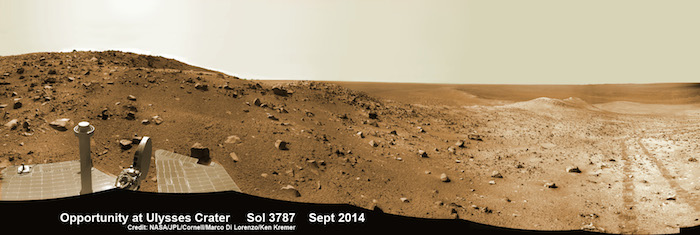
NASA’s Opportunity Mars rover peers out toward Ulysses crater, ejecta rocks and Martian plains beyond from her Endeavour crater rim location on Sept. 18, 2014. Notice dramatic wheel tracks (right) as rover ascends steep crater slopes. This navcam camera photo mosaic was assembled from images taken on Sol 3787, Sept. 18, 2014 and colorized. Credit: NASA/JPL/Cornell/Marco Di Lorenzo/Ken Kremer
.
Today, Dec. 27, marks Opportunity’s 3884th Sol, or Martian Day, roving Mars. She has snapped over 199,400 amazing images since her air-bag assisted touchdown on Jan. 24, 2004, inside Eagle crater.
She was expected to last a mere three months—with a “warranty” of 90 Sols. That’s an unbelievable 43 times beyond her expected warranty. It’s like we launched 43 rovers to explore the Red Planet for the price of one rover launch, way back in the summer of 2003.
Opportunity’s total odometry is 25.73 miles (41.42 kilometers).
She recently surpassed another interplanetary record for distance driving on another world—exceeding 41 kilometers on Sol 3837 (Nov. 9, 2014).
The robot has sufficient power for the exciting, upcoming research endeavors, comprising her ground-breaking science expedition, following a series of fortuitous wind cleaning events earlier in the year that substantially cleared the dust off the power generating solar wing arrays.
The solar array energy production currently stands at 494 watt-hours, compared to about 900 watt-hours at landing in 2004 and only about 270 watt-hours just before Christmastime in December 2013.
The mineral-rich mountain caches of Marathon Valley at Cape Tribulation lie just ahead.
And this past Oct. 19, Opportunity accomplished astroimaging of the Oort Cloud comet Siding Spring during its close-by of Mars.
Meanwhile, younger sister Curiosity is surveying and drilling into the foothills of another truly enormous Martian mountain on the opposite side of the Red Planet, called Mount Sharp.
And scientists just announced Curiosity’s discovery of methane, organic molecules, and a lake inside the Gale crater landing site. Read all about it here and here.
.
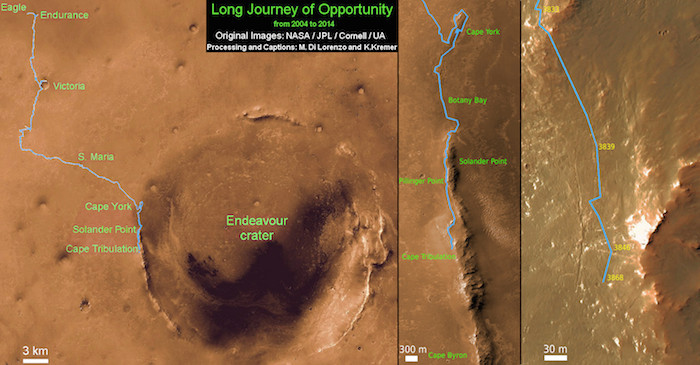
Traverse Map for NASA’s Opportunity rover from 2004 to 2014. This map shows the entire path the rover has driven during a decade on Mars and over 3870 Sols, or Martian days, since landing inside Eagle Crater on Jan 24, 2004 to current location by Cape Tribulation summit at the western rim of Endeavour Crater. Opportunity discovered clay minerals at Esperance – indicative of a habitable zone – and is searching for more at Cape Tribulation. Credit: NASA/JPL/Cornell/ASU/Marco Di Lorenzo/Ken Kremer
Quelle: AS
.
Update: 1.01.2014
.
NASA team hacks Opportunity to treat Mars rover's amnesia

NASA’s Mars rover Opportunity has been working well into its golden years – after nearly 11 years roaming the Red Planet, it has survived more than 40 times past its warranty. But now, this trusty veteran explorer is experiencing some worrisome memory loss.
The long-lived rover has been having some senior moments, according to John Callas, project manager for the Mars Exploration Rover mission (as Opportunity and its defunct twin Spirit are formally known). The episodes of amnesia stem from faulty flash memory – the kind of memory in your digital camera that allows your pictures to stay saved even after your device is turned off.
But flash memory doesn’t last forever – and the seventh, final bank in the flash memory appears to be malfunctioning.
“Flash memory has a limited lifetime,” Callas said. “It only allows so many read-write cycles before it starts to wear out some of the cells. And after 11 years of operation on Mars, we now suspect we’re seeing a wear-out of some of those cells.”This leads to a pair of problems. Since the rover can’t use the seventh memory bank, it uses its random-access memory – or RAM, the kind of memory your computer uses when it’s on for temporary data storage. The problem is, as soon as the rover (or your computer) is switched off, the information stored in RAM is lost. So if the rover turns off before sending all of its at-risk data back to its handlers at the Jet Propulsion Laboratory in La Canada Flintridge, then those data are lost forever.
That’s an annoying, but manageable, issue, Callas said. The second snag is that the flash memory issue also causes the rover to reboot – and when it reboots, it stops the long-term activities the team had planned for the rover and simply waits for further instructions on the ground. On weekends and over the holiday season, when people are out of the office, these unexpected hang-ups can put the team days behind schedule, Callas said.
“It’s like you’re taking a family trip and your car stalls, and every time your car stalls you have to call triple-A — but now it’s stalling every 20 miles,” Callas said. “You’re not going to make much progress.”The researchers do have a clever little fix, Callas added. They plan on modifying the software so that the rover thinks it only has six banks’ worth of flash memory – which should make it skip faulty bank No. 7, since that’s at the very end. (They’re lucky the faulty segment wasn’t right in the middle of the flash memory module, Callas added – that would make a fix much more complicated.)
“You have a piece of lettuce you want to put on your sandwich and the edge of the lettuce is a little bit brown, and you just cut it off and you put the rest in your sandwich and you go,” Callas said by way of analogy. “Maybe you have a little less lettuce, but it doesn’t have any brown on it.”
Opportunity, which along with its twin Spirit arrived at the Red Planet in early 2004, set out to find signs of past water on Earth’s dry, dusty next-door neighbor. It did that and more, even finding evidence of past habitable environments in its later years that complemented the findings from its descendant, NASA’s 2012 rover Curiosity.
Opportunity was never meant to last this long, and it’s picked up a number of scars along the way. It’s been described as arthritic, with a gimpy elbow and a somewhat disabled front wheel, but that hasn’t kept the robot from logging roughly 26 miles on the Red Planet.
It’s unclear how long Opportunity will last, said Callas, who compared the aging rover to an elderly parent (one in good health, who still plays tennis every day).
“With each passing day we get one day closer to that end … but until that time, we’re going to keep going, keep exploring,” Callas said.
Quelle: Los Angeles Times
4252 Views
